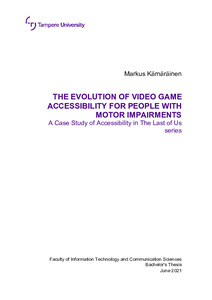The Evolution of Video Game Accessibility for People with Motor Impairments : A Case Study of Accessibility in The Last of Us series
Kämäräinen, Markus (2021)
Kämäräinen, Markus
2021
Viestinnän monitieteinen kandidaattiohjelma - Bachelor's Programme in Multidisciplinary Communication Studies
Informaatioteknologian ja viestinnän tiedekunta - Faculty of Information Technology and Communication Sciences
This publication is copyrighted. You may download, display and print it for Your own personal use. Commercial use is prohibited.
Hyväksymispäivämäärä
2021-08-11
Julkaisun pysyvä osoite on
https://urn.fi/URN:NBN:fi:tuni-202106226025
https://urn.fi/URN:NBN:fi:tuni-202106226025
Tiivistelmä
My thesis seeks to produce knowledge on the evolution of video game accessibility for players with motor impairments. The research aims to analyse the state of accessibility in The Last of Us games. Additionally, it assesses the games’ ability to maintain pleasurable accessible player experiences. The goal is to indicate how accessibility has evolved between The Last of Us games. Formal analysis was used for gathering and sorting data. Furthermore, the analyses of the games’ mechanics, interactions, accessibility barriers, and accessibility solutions were conducted by several frameworks. In addition, both games’ pleasurable accessible player experiences were analysed separately. Lastly, the results were collected into a table and compared to determine the evolution of accessibility between The Last of Us games. The general state and different approaches to video game accessibility as well as previous research were disclosed via literature review.
The results indicate that the status of accessibility has evolved from inaccessible The Last of Us to accessible The Last of Us Part II. The researched sequence in The Last of Us possesses multiple accessibility barriers that cannot be surpassed, whereas The Last of Us Part II has plenty of accessibility solutions to overcome most of the encountered barriers. Furthermore, the analysis suggests that the sequel greatly supports pleasurable accessible player experiences, while the first game does not.
The analysis implies that most of the accessibility barriers come from quick-time-events and inadequate input requirements. Other issues are caused by timed events, enemy behavior, and high precision requirements. The Last of Us Part II responds to the barriers by offering multiple alternative input methods, automatized or reduced interaction strategies, and highly customizable gameplay.
The results indicate that the status of accessibility has evolved from inaccessible The Last of Us to accessible The Last of Us Part II. The researched sequence in The Last of Us possesses multiple accessibility barriers that cannot be surpassed, whereas The Last of Us Part II has plenty of accessibility solutions to overcome most of the encountered barriers. Furthermore, the analysis suggests that the sequel greatly supports pleasurable accessible player experiences, while the first game does not.
The analysis implies that most of the accessibility barriers come from quick-time-events and inadequate input requirements. Other issues are caused by timed events, enemy behavior, and high precision requirements. The Last of Us Part II responds to the barriers by offering multiple alternative input methods, automatized or reduced interaction strategies, and highly customizable gameplay.
Kokoelmat
- Kandidaatintutkielmat [7047]
